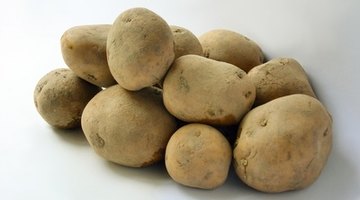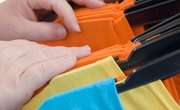Dressing up your potatoes for a school project can make the difference between having a presentable and "A" worthy diorama and getting a bad grade because you didn't put enough effort into your project. Since potatoes are bare, they can act as a blank surface that can hold many different types of accessories and clothing attire. You will have to stitch your own clothing, because not all potatoes are the same size; some are longer or rounder than others. Ultimately, adding distinct details to your "potato people" can help teachers notice your project.
Cut out clothing patterns depending on the way you want to dress your potato. "For example, if you want a shirt, fold the clothing material in half and draw a shirt on the piece of material, and then cut the pattern. You can use this technique with pants and dresses, but make sure that clothing is big enough for your potato," according to Michaels assistant manager Gina. R. You will need to cut two pieces--a back and a front--for each garment.
Align the two pieces of cut fabric, thread a needle and begin to stitch the clothing. Push the needle in and out of the fabric along the open side(s) of the clothing and tighten the thread along the way to secure the seam. Leave the top and bottom of your shirts or dresses open (for the "head") so that you can put them over the potato. With pants, you must stitch across the bottom and leave the top ("waist") open.
Add accessories to the clothing to make the potatoes look more realistic. Draw items such as buttons, zippers, and shirt pockets from another piece of fabric, cut them out, and then glue the accessories onto the piece of clothing. You can also cut out other articles of clothing, such as glasses, shoes, pipes, hats, or other props like books, swords, etc. from either your fabric, felt, or construction paper, and add them to your potato to make the character more realistic and identifiable.
Draw other details, such as pant pockets, T-shirt and dress designs, eyebrows, mouth, ears and a nose. According to the assistant manager at Michaels, Gina R., "felt-tip permanent marker works best while designing, because it will stay on the fabric for a long while."
Glue the yarn on top of the potato to create hair. Use a small brush to style.
Poke plastic eyes (available at craft stores) onto the face of the potato. You can then glue on the glasses that you cut out earlier, if desired.
Put on the clothes that you cut out and stitched in Steps 1 and 2 to complete the dressing up of your potato.
Create a diorama to display the dressed up potatoes. A diorama is a school project that displays a historical event or a novel's scene inside of a shoebox. Decorate the box with construction paper, markers, paint and the remaining felt fabric cut into additional scenery (for example, trees, sky, waves, a house, snow) to best display the scene. Position your potatoes inside of the cardboard box to set up your scene and glue them in place.
Let the potatoes dry inside of the diorama. If you set your potatoes standing up, you may have to hold each for 5 to 10 minutes or until the glue dries. Do not carry or move the diorama for a couple of hours to ensure that the potatoes have dried.










